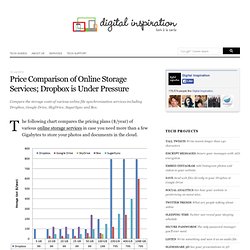

Price Comparison of Online Storage Services: Dropbox, SkyDrive, Google. 15 Jul 2012 Compare the storage costs of various online file synchronization services including Dropbox, Google Drive, SkyDrive, SugarSync and Box. couch mode print story The following chart compares the pricing plans ($/year) of various online storage services in case you need more than a few Gigabytes to store your photos and documents in the cloud.

It turns out that Windows SkyDrive offers the best value for money ($/GB/year) but if your storage requirement exceeds 100 GB, Google Drive is the way to go. Everyone’s favorite service Dropbox looks pretty expensive at this time – they offer 100 GB space for $199/year ($2/GB) while SkyDrive charges $50 (or $.5/GB) and Google charges $60 (or $.6/GB) for the same amount of online storage.
The aggressive pricing strategy adopted by Microsoft and Google has put lot of pressure on Dropbox to lower prices and offer smaller plans. My $99 Dropbox yearly plan just auto-renewed and I don’t know if I feel good about it in light on this weeks news. Test ur hard drive. This guide descibes how you can test the health of your computer’s hard disk before they malfunction.

Also learn about free hard drive diagnostics tools that can catch most drive errors. Hard disk failure is possibly the worst thing that can happen to your computer and it often occurs without giving any warning signs. You may however run certain tests on your computer beforehand to get an idea about the current condition of your hard disk. This should in turn help you decide whether a replacement drive is necessary or not. Step 1: Check your hard disk for errors All recent versions of Windows include a utility called Chkdsk.exe that can check your hard disk for any bad sectors. You may either run Chkdsk from the command line (see details) or launch Windows Explorer, right click the drive that you wish to examine and choose Properties. Step 2: Understand the sounds of your disk Do you sometimes hear strange sounds coming out of the CPU box? Step 3: Catch errors before they happen. Google Drive. Just like the Loch Ness Monster, you may have heard the rumors about Google Drive.

It turns out, one of the two actually does exist. Today, we’re introducing Google Drive—a place where you can create, share, collaborate, and keep all of your stuff. Whether you’re working with a friend on a joint research project, planning a wedding with your fiancé or tracking a budget with roommates, you can do it in Drive. You can upload and access all of your files, including videos, photos, Google Docs, PDFs and beyond. With Google Drive, you can:Create and collaborate. Drive is built to work seamlessly with your overall Google experience. This is just the beginning for Google Drive; there’s a lot more to come. Get started with Drive today at drive.google.com/start—and keep looking for Nessie... DIY data centers: Backblaze reveals secrets of cloud storage. If Hollywood ever needs a cloud storage facility for a movie scene, they need to call the folks at online storage and backup company Backblaze.

You can just picture Tom Cruise, playing a secret agent dressed in black, sneaking around the rows of shiny red pods in the white storage facility (half a city block long). This is what cloud storage should look like, and the company is now sharing their secrets. You too can make a 135-terabyte, 4U server for $7,384. Today Backblaze posted a new blog full of information most companies keep hidden about building and running a 15+ petabyte cloud storage farm. “When we first open-sourced the storage pod design in 2009, it was the first time it had ever been done,” says Gleb Budman, co-founder and CEO of Backblaze, in an interview with VentureBeat. “500,000 people read the blog post and hundreds of companies around the world have since built the storage pods for their own purposes.” Backblaze calls those 135-terabyte, 4U servers “storage pods.”